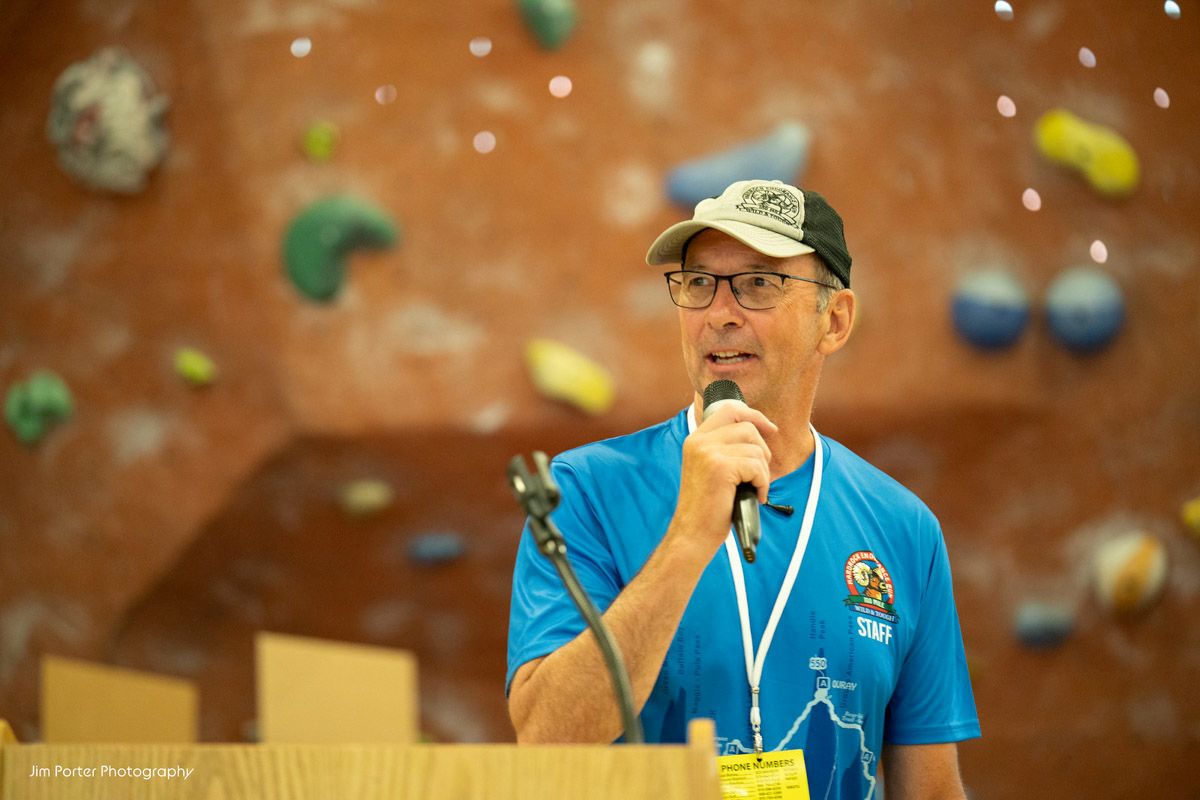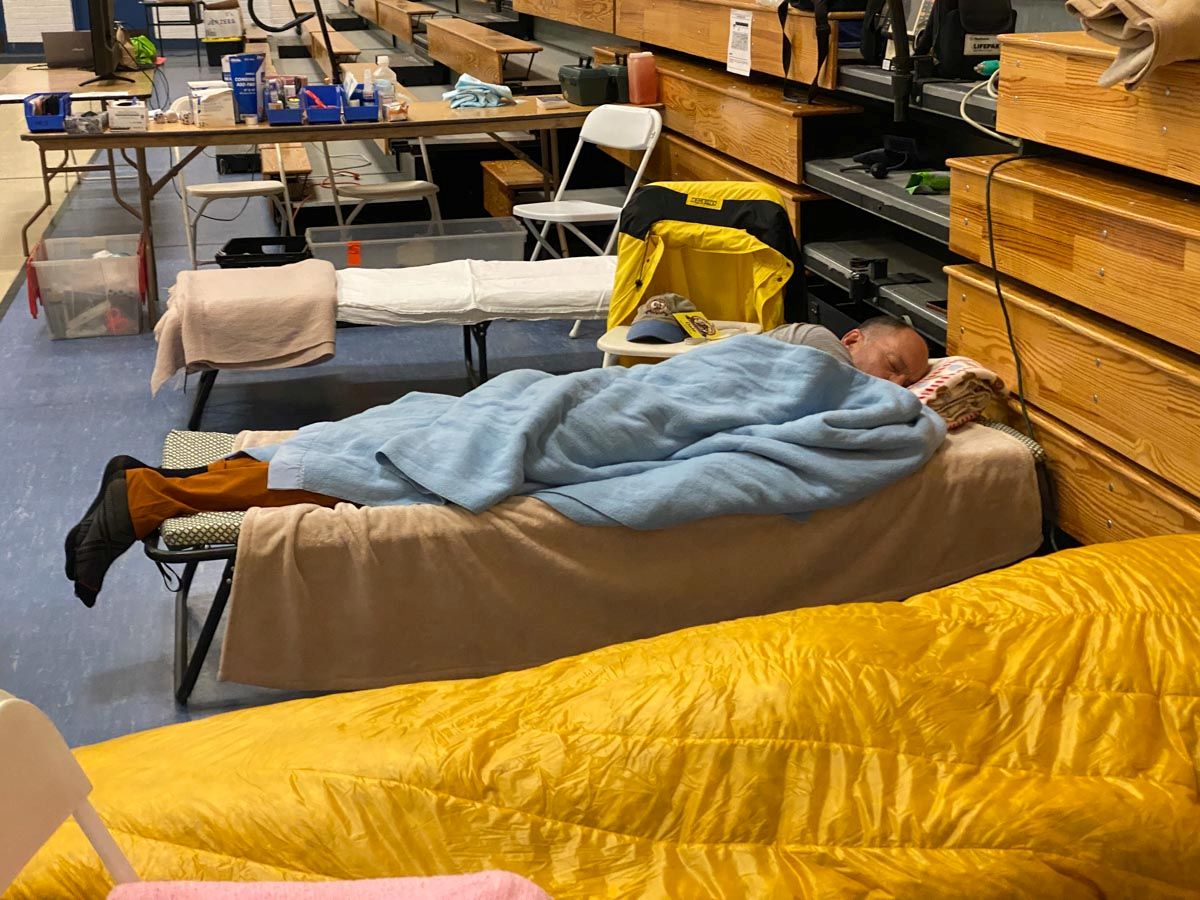In running circles, Dale Garland is best known as the run director and one of the original founders of the Hardrock 100, held in Silverton, Colorado, each summer. He’s a beloved figure known for greeting each runner of the event at the finish, no matter the hour or weather. He’s also known as a well-loved teacher who spent all 31 years of his career at the same school in Durango, just an hour south of Silverton, passing on important leadership lessons to his students and dragging some of them, most famously Dakota Jones, into the running world with him. Garland has had such an outsized influence in the ultrarunning world as he heads into the 2025 event, its 30th running, that it’s hard to imagine what it would be like if he’d chosen a different life path.
But Garland’s trajectory to being Hardrock’s run director from the start in 1992 was anything but guaranteed. If it wasn’t for reading about the Colorado Trail being built in his Durango backyard in 1986 to nudge him toward wanting to run it, he may have never gravitated toward trail running. And if it weren’t for a stop in Leadville on his Colorado Trail trip, he may never have heard of or entered the Leadville 100 Mile and gotten into ultra racing. And if that hadn’t happened, Garland may never have encountered Gordon Hardman and his idea to start Hardrock. And if bad hips hadn’t taken him out of the sport prematurely, Garland may have never had the time to dedicate to growing the event into what it is today.
Regardless of the opportunities placed in front of him, Garland seems to say yes to them and has a willingness to take risks on big ideas. He’s shown time and again that he can build a team with the right combination of skill sets around him for success, and a self-belief that it will all work out. And when he messes up, he learns from his mistakes. Some of his favorite stories to tell are of how two of Hardrock’s most revered traditions arose from him messing up during the first running of the event. For Garland, there’s a solution to any problem, and there’s always a way to do something better. This willingness to learn, adapt, and take on big projects has taken Garland on a journey that is as extraordinary as it is unlikely.
First Running of the Colorado Trail
Most ultrarunners follow a somewhat traditional path into the sport, starting with shorter races and gradually increasing distance as they build endurance and experience. Although Garland, coming of running age in the era of Frank Shorter and the road running craze of the 1980s, had done a fairly standard progression of road running, starting with 5ks and building to marathons, his jump in distance in trail running was anything but traditional.
Living in Durango, Colorado, in 1986 after graduating from college, Garland read an article about the building of the Colorado Trail. The 486-mile trail was set for completion in 1988, and when Garland reached out to Gudy Gaskill, the matriarch of the trail and project, asking how he could be involved, she suggested that he run the trail from Durango to Denver and get there in time for the opening ceremonies. Garland immediately latched onto the idea, regardless of the fact that he had minimal experience in the ultrarunning world, which was very much in its infancy in the late 80s. He was fresh out of school and looking for an adventure.
Garland, a sixth-generation Coloradoan, grew up in Arvada on the Front Range, just outside of Denver. Not ready to go to college after being “a typical high school kid,” he joined the U.S Army for three years after graduating. Of the experience, he says, “I was ready to go to college after that,” and he settled on Fort Lewis College in Durango.
The small college has always had a reputation for encouraging student involvement in mountain sports and the outdoors, and Garland says, “I got immersed in it. There was a pretty strong running culture there and access to trails and everything like that. It was where I cut my running teeth.” With the La Plata Mountains rising to the west and the San Juan Mountains to the north, Durango is a playground for mountain athletes of all kinds, and Garland embraced the culture and community.
With the Colorado Trail idea nestled in his brain, Garland immediately went to work turning it into a reality. He says, “I knew I couldn’t do it by myself, and so I started talking to some friends.” He managed to convince three others to join him on the venture. When describing the initial state of the crew, Garland says, “The farthest one of us had run once, I think, was a 50k. That was a total sum experience of our ultrarunning experience or expertise.”
But Garland and his friends had the gumption to make it happen. Or maybe they just lacked the sense to realize that what they were attempting was huge and improbable given their experience level. He does admit that they had many people questioning their mission, but explains, “We were all kind of goal-oriented, and we had this goal that we wanted to do.” While their families were skeptical at first, they signed up to support the quartet along their run by agreeing to shuttle their gear and set up their camps each night. The whole thing became a family affair.
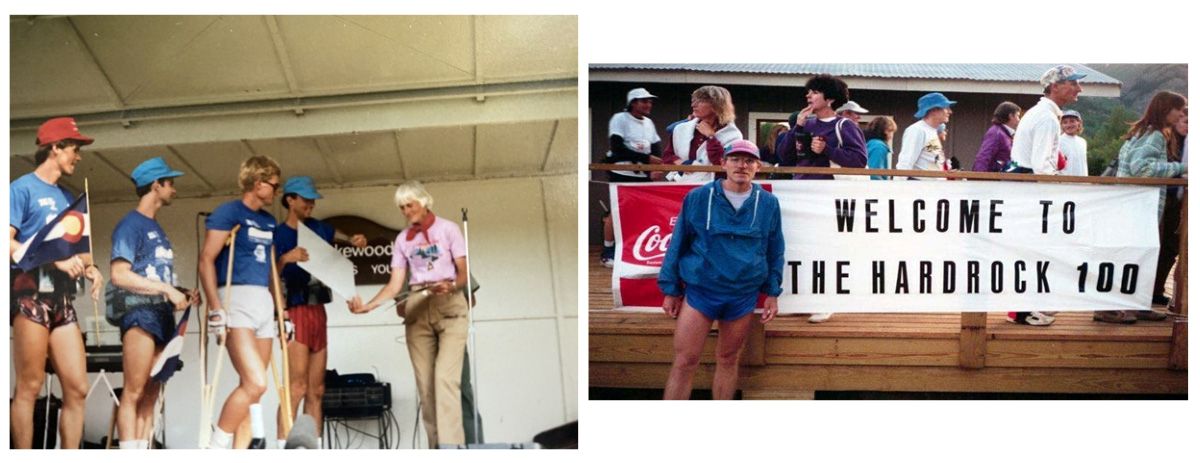
Dale Garland after finishing the Colorado Trail in 1988 (left) and an early edition of the Hardrock 100 with veteran Hardrock 100 finisher Blake Wood pictured (right). Photos courtesy of Dale Garland.
Garland says they all assumed different roles in the planning and execution of the run. “We had the navigator, and we had the physical therapist. My job was to be the PR cheerleader kind of guy and the overall organizer.” He goes on to explain his skill set, “I’d done a lot of race directing in Durango for the Durango Motorless Transit group, now more commonly known as the Durango Running Club, and so logistics and organization came easy to me.”
As for the physical side of things, he says, “We did spend a lot of time learning about running long distance on trails, and we kind of took the risk and figured it out as we went.”
While navigation of the newly cut and sparsely marked trail proved difficult, the group made it from Durango to Denver in 17 days, just in time for the opening ceremonies. Garland says, “It was a transformative experience for me because that’s where I really developed this love of long-distance running and being in a community of people who thought this was pretty cool.” There was a sense of pride that came from being the first ones to run the trail. Garland says, “After that, ultrarunning and long-distance trail running became my thing, and I just never looked back after that.”
Seeds of Ideas
If a chance reading of a magazine article about the building of the Colorado Trail nudged Garland into ultrarunning, it was a stop in Leadville during the Colorado Trail run and a chance encounter with a poster advertising the Leadville 100 Mile that provided the next step. Having done a few 50-mile races in preparation for the Colorado Trail, Garland reached out to Merilee Maupin (formerly O’Neal), the co-race director of Leadville, and asked if he could run. He says, “This was 1988 when if you had a pulse, you could run most of the 100 milers, and there weren’t very many.” This was long before the days of lottery systems, waitlists, and events with thousands of people.
Garland finished the race and loved it. He went back the year after, and the year after that, finishing the race four times between 1988 and 1991 and as high as sixth place in 1990. Over the time period, he became friends with Maupin and Ken Chlouber, the other co-director, and admired the way they used the race as a way to bring economic development to their town, which they had watched crumble economically as the big local mine, called the Climax Mine, declined in productivity and eventually closed in 1987.
After a couple of years of racing Leadville, Garland came across a small blurb in “UltraRunning Magazine,” the main source for ultrarunning news in the late 80s. Garland describes reading the page in the magazine, saying, “It was almost like an ad from a guy who said, ‘I’m thinking of organizing a 100-mile run in southwest Colorado connecting the four mining towns of Silverton, Telluride, Ouray, and Lake City.’” The goal, like in Leadville, was to bring economic development to an area that was struggling after the end of mining in the region. It was only a few words, but it was enough to spark Garland’s interest, and he reached out to the author, Gordon Hardman. Although the two tossed the concept around, Garland put the idea on the shelf to pursue other ventures, like running the Western States 100.
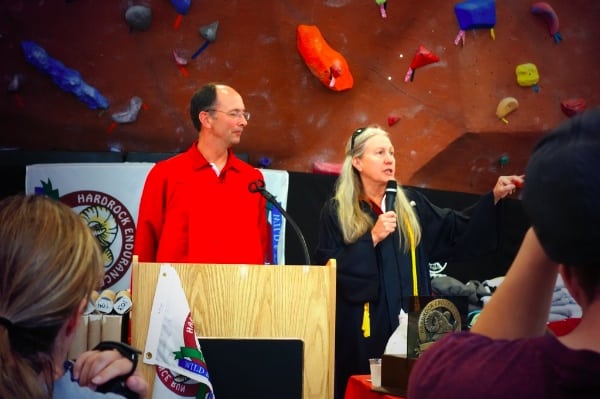
Dale Garland with the now retired aid-station coordinator, Lois MacKenzie, at the 2013 Hardrock 100 award ceremony, or what they call ‘graduation.’ Photo: iRunFar/Bryon Powell
Getting Volunteered for Hardrock 100
In 1990, Garland was deep into the groove of ultrarunning and had traveled to California to race Western States. Hardman was also racing the event, and Garland’s dad ended up hanging out at an aid station with Hardman’s wife. As tends to happen when waiting for runners at aid stations, the two started to talk, and according to Garland, his dad told Hardman’s wife, “Gordon should lean on Dale. I know Dale would love to help him organize Hardrock.”
After the race, Garland and Hardman got back into contact and started planning in earnest. Their first step was to recruit help, and as Garland had done with his Colorado Trail run, they put together a team with a wide range of talents.
Garland explains, “Gordon had some experience with ham radios, so he got some of his ham radio buddies to help. John Cappis and Rick Trujillo, who had both grown up in the area, knew the trails on the course really well, so they evolved into the course directors. Charlie Thorn was our historian. He was the guy who kind of kept all the records and kept us organized.”
That left Garland to deal with the actual race logistics, and he turned to his friend from Leadville, Maupin, for advice. She helped him with the details, including thinking about small things that Garland would have never considered. The mentorship was invaluable and helped Garland to plan an event far beyond the scope of anything he’d done before.
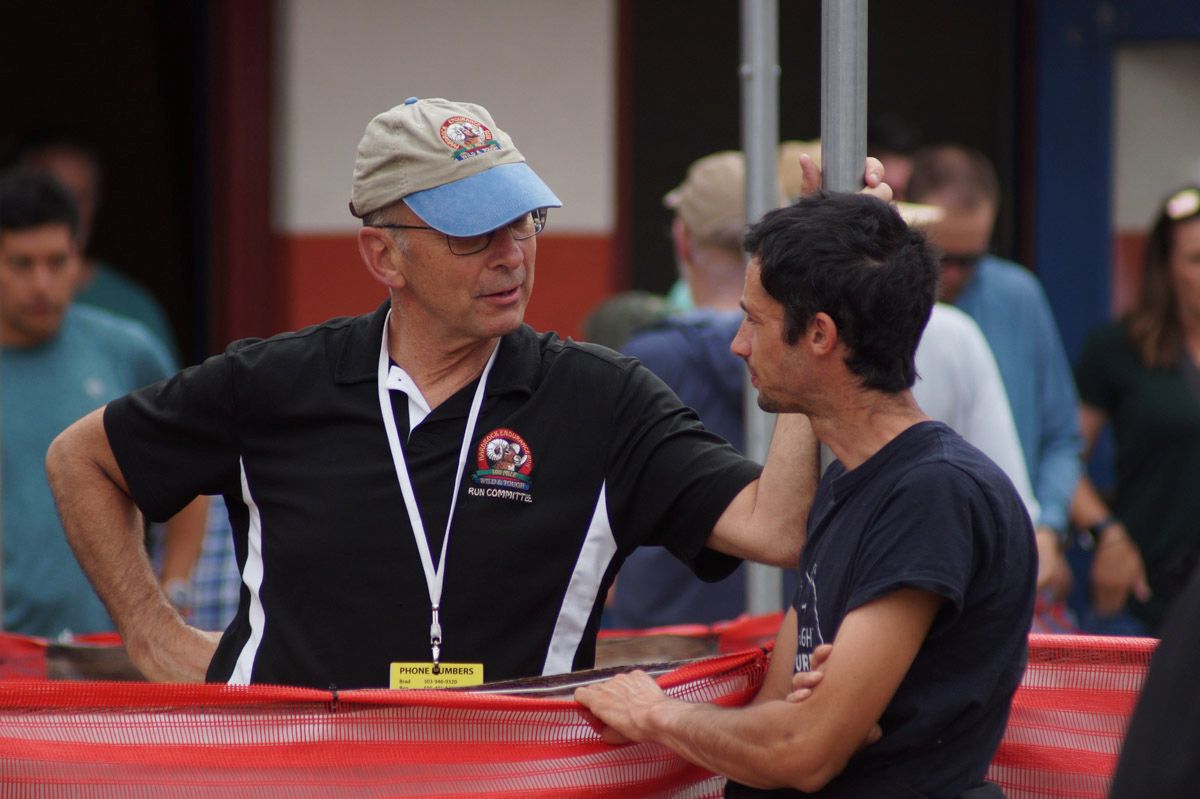
Garland talking to Kilian Jornet after a more recent edition of the Hardrock 100. Photo courtesy of Dale Garland.
Mistakes to Traditions: The Early Hardrock Years
After more than a year of planning, the group launched the first edition of the Hardrock 100 in 1992. David Horton won, and Hardman, Thorn, and Cappis placed third through fifth in a field of 18 finishers. Garland calls it a “huge learning experience,” and goes on to say, “We’re lucky we didn’t kill anybody.” Their course markings got eaten by marmots, and Garland says, “I’m surprised everybody came back, to be honest.”
The various small details aside — like course markings — Garland had forgotten a key component of putting on a race, only to realize it when someone at the start line asked what the actual finish line was. Garland had completely forgotten to think about that, so he improvised, telling the runner, “You have to go touch that rock.”
Touching the rock eventually turned to kissing the rock, and over the years, the original rock turned into a big rock used during the rock drilling competition at the Hardrockers Holidays event, also held in Silverton, with the Hardrock logo painted on it. When that first painted rock cracked in half, they got a new one. Now a racer isn’t considered finished until they kiss the rock. It’s an instantly recognizable photo the trail running world over.
What started as an oversight quickly morphed into one of the most iconic traditions of the race.

The original Hardrock 100 rock, being kissed by a proud finisher. Photos: Blake Wood and Dale Garland
That same first year, on the second night of the event, Garland and the rest of the organizers were huddled in a camper they had set up at the finish line, exhausted from the effort of putting on the event, when they heard a knock at the door. Garland says, “This guy, and I don’t remember who it was, I wish I did. He goes, ‘I just finished Hardrock. Is there anybody I should tell that I finished?’”
Garland felt awful that this racer had just completed such a huge accomplishment and arrived back at an empty finish line. He says, “That really made me think somebody should always be there to say congratulations, and so I made it my mission to be at the finish line for every finisher, so that never happens again.” More than 30 years later, Garland still makes a point to greet as many racers as he can, and if he can’t, he makes sure that someone else is there in his place.
Out of a mistake comes another Hardrock tradition that has become a fixture of the event.

Anne-Lise Rousset finishes the 2023 Hardrock 100 in second place, and kisses the modern-day Hardrock rock. Photo: iRunFar/Meghan Hicks
Modern-Day Hardrock
As Hardrock was launched in 1992, Garland’s own running career was coming to an end. That year, Garland had to drop out of Leadville due to hip pain. Not long after, he underwent two hip-replacement surgeries and had to come to the acceptance that his running career was over. He says, “Once I found out that I couldn’t run anymore, I went through denial. I went through anger. I went through, Okay, what am I going to do now?” While Garland could replace running with hiking, Hardrock became his way to stay connected to the ultrarunning community because leaving it all behind was out of the question. The timing of the injury put Garland in a situation where he could focus the energy and time that he’d previously put into his own personal running into the event itself. This shift in priorities, while hard for Garland at the time, is potentially the reason Hardrock has grown into what it is today.
It’s been a long time since Garland and the original Hardrock team put together a scrappy event through the San Juan Mountains. Now, there’s a 21-person run committee, a lottery to get in, and a finish line that is never abandoned by fans. High-profile athletes have brought international attention to the event, and people wait years for their opportunity to run.
Yet, much of the event stays the same. It still maintains its close-knit feel; the mountains it traverses are still massive; and everyone who is involved, whether racing, crewing, spectating, or volunteering, feels like they’re part of something. Garland says of the growth, “It was never our intent to be the next Western States. It was never our intent to be a competitor of Leadville or to be the biggest and best and baddest and whatever. It was just about doing something that we all believed in, that we had shared values in.” The original values still feature prominently on the event’s website, and in many ways, at its core, the 2025 event isn’t all that different from the original as it heads into its 30th edition.
It’s hard to fathom what Hardrock would look like now had Garland not read that article on the Colorado Trail in 1986 and gone out to run it in 1988, or had he not learned of the Leadville 100 Mile, or had his hips held up to a long and healthy running career. It’s easy to chalk all these events up to probability and to imagine that had Garland not found himself as an ultrarunner ultimately working with Hardrock, he would have ended up equally as involved and passionate about something else, because that’s just who he is. But it was running and the San Juans that captured his imagination so many years ago, and it’s fair to say that the ultrarunning community is better for it.
Call for Comments
Have you had the pleasure of meeting Dale Garland? Tell us your stories about him.
